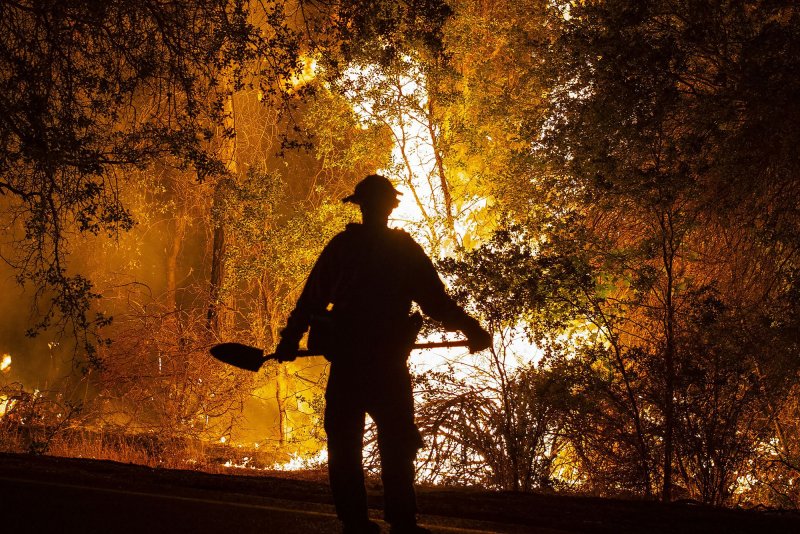1 of 7 | A firefighter is seen Wednesday monitoring the River Fire, which has blackened more than 1,400 acres so far near the town of Colfax, Calif. Photo by Peter DaSilva/UPI |
License Photo
Aug. 5 (UPI) -- "These are the heroes of the Union Pacific."
A specialized group of firefighters has been deployed in an effort to save communities and infrastructure from being torched by a number of wildfires that are burning across the Western United States.
But the firefighters can't travel to just any fire that sparks to life. They need to follow the road -- or in this case, the rails -- ahead of them.
Since it was created in the 1980s, a fleet of Union Pacific Railroad fire cars has been sent all across the West to battle blazes near the company's railroad tracks.
"They protect our railroad they protect our communities," Eric Gehringer, Union Pacific executive vice president of operations, told AccuWeather's Bill Waddell.
"There's been many instances in which we've transported firefighters into some of the more rugged terrain."
Union Pacific has 50 water cars in its fleet that can respond to wildfires in California, Oregon, Washington and Colorado. Each has been retrofitted with "water cannons" that can spray water 150 feet from the track.
"We're just wetting down our infrastructure and adjacent properties to protect it in the event that we do come up against a forest fire," Gehringer added.
With the 2021 fire season well underway, the team of firefighters has been busy, but one particular fire in Northern California last month proved to be too dangerous even for the water cannons.
In late June, a fire car was sent to assist with the Lava Fire, which was burning in the Shasta-Trinity National Forest. When the train arrived, though, there was a major problem.
The Union Pacific train arrived at the Dry Canyon Bridge to find that it was severely damaged by the flames, and was too dangerous to cross.
"We could see the bridge was on fire -- smoke was all around it, and there were small spot fires all over. At that point, we couldn't get close enough with the water tanks because the track was compromised," Jamie Hill, UP director of bridge maintenance and engineering, said.
![]()
The Dry Canyon Bridge is seen after the Lava Fire scorched the area in June. Photo courtesy Union Pacific
The damage was so severe that crews are still working to rebuild part of the bridge. It's estimated to reopen by Sept. 1, according to Union Pacific.
Until the bridge is fixed, the fire crews will travel elsewhere across the West to aid in what's already been an active wildfire season -- but the start of the season is just the tip of the iceberg.
AccuWeather meteorologists are predicting that close to 10 million acres of land will be scorched in the West during the 2021 wildfire season, which would rank as one of the most dangerous on record.
"We're forecasting a top-five year based on the pace, the fuels, the upper pattern and the drought situation, all of that was factored in our forecast," AccuWeather long-range expert Paul Pastelok explained.
The crews will be out in force over the next several months as the fire season intensifies, protecting property and helping to contain potentially devastating wildfires.
"They are absolute heroes in my eyes," Gehringer said.
Additional reporting by AccuWeather National Reporter Bill Waddell.
Pedestrians take photos of and enjoy the snow covered trees in Central Park
after a winter storm in New York City on January 7, 2022. Photo by John Angelillo/UPI |
License Photo

















